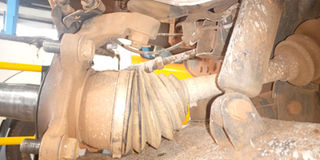Prime
Understanding how your CV joints work

Most CV joints feature six hardened steel balls, which ride in grooves in the inner race. PHOTO BY ROLAND NASASIRA
Mechanically, the constant velocity (CV) joint transmits torque or power from the transmission system to the tyres at constant rotational speeds.
Innocent Onyango, an automotive engineer at Nissan Motorcare, says when one of your CV joints fails, there will be no rotation in the wheels. However, before the CV joints fail completely, there are different stages or signs of failure.
The first is that CV joints have boot kits which cover the turning joint. In the joints, there are either balls or bearings with grease. Special high temperature grease maintains the CV joint from wear and tear due to friction.
This is because the CV joint is a high velocity-moving component that is protected by rubber boots and two clamps on both sides so that it is maintained without spilling out.
If the grease is to spill out, which is a sign of wear, then the rubber boots are old. By spilling, the amount of grease reduces from the CV joints.
“In the long run, there will be heat generated because there will be insufficient grease to cool and lubricate the joints. If you do not realise that there is spilling grease, the gaps between the bearings keep widening and they might jump out,” Onyango explains.
A failing CV joint
There are two CV joints; on the inner and outer sides of your tyres. To know that the outer joint is worn out, when you look at the rims, you will see grease since when the wheel rotates, it splashes grease on the rim. Also, if you hear a clicking sound, especially when turning or negotiating a corner or bend, then your CV joint is faulty.
“When you ignore the clicking sounds, the outcome will be CV joint failure. However, CV joint failure can be managed if you pay attention to the signs,” Onyango advises.
Dangers
Sula Kilimani, a mechanic at Kisekka Market, agrees with Onyango, saying it is rare for you to get an accident as a result of a faulty CV joint because the noises it makes when it requires mechanical attention allows you ample time to attend to it.
He observes that if the grease from the rubber boot is spilling onto the rim, one of the solutions is to get a new boot kit that comes with new grease. If it is totally worn out, for safety, replace everything.
According to Onyango, most car service manuals indicate that A CV joint can be serviced after covering 300,000km only if the rubber boots are not damaged.
“The preventive solution is to carry out regular diagnosis and inspection of the joints to find out if they require any service to allow them serve you longer rather than wait for when they need replacement,” Onyango advises.
Driving habits
According to Kilimani, your driving habits do not matter as far as damage of the CV joints is concerned.
You, however, have to worry about the road you drive on. For instance, if you drive on murram roads, with time, the dust goes into the rubber boot and causes it to develop cracks, wearing out overtime. If you also drive in a bush, something might pierce the rubber boot.
“Most modern cars have suspension systems that have suspension arms. When a car is moving on bumpy roads or rough area, one arm goes up and the other goes down. Where this up and down movement of arms takes place is where CV joints are located and it is at these points that you have to drive cautiously,” Kilimani advises.
Cost of replacement
To save you from buying a drive shaft that houses the CV joint, frequent diagnosis or inspection is paramount, especially every time you service the car. If you ignore it, in the long run, you may have to spend at least Shs2.5m on a new drive shaft.
According to how important, an online portal, a damaged CV joint will only allow your car to run for a maximum of 500 miles before it separates and breaks loose. Consequently, if this happens while you are driving, chances are your car will be involved in an accident. Therefore, vigilance and timely service is recommended.
How to test
• Examine the rubber boots located on the axle shaft next to the wheel. If it show signs of damage or is covered with grease, the boot has been compromised.
• Accelerate and decelerate quickly, but smoothly, taking note of any lurching or shuddering located in the axles while listening for a ‘clunking sound.




